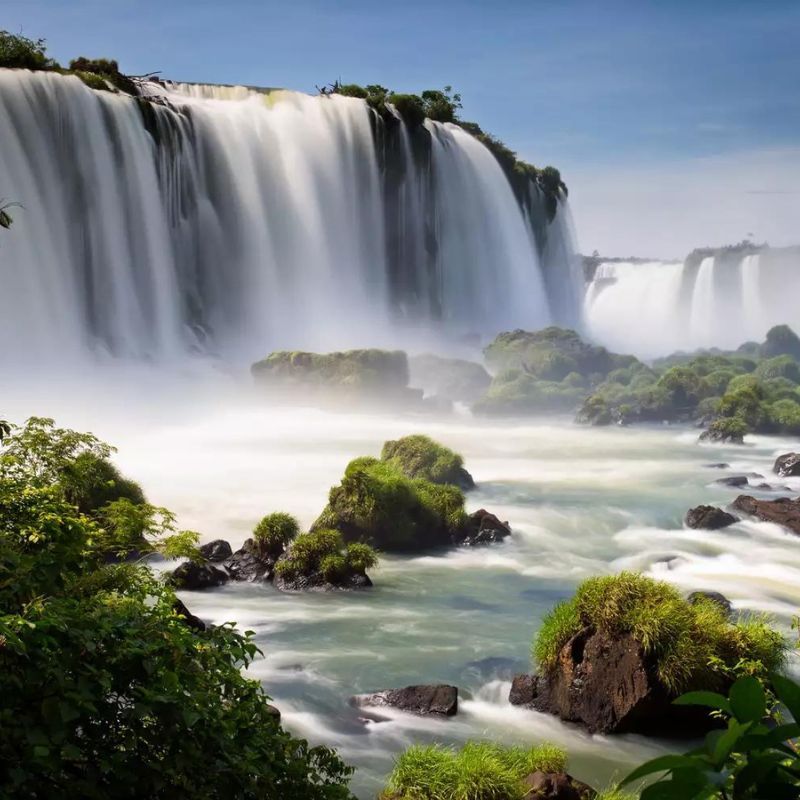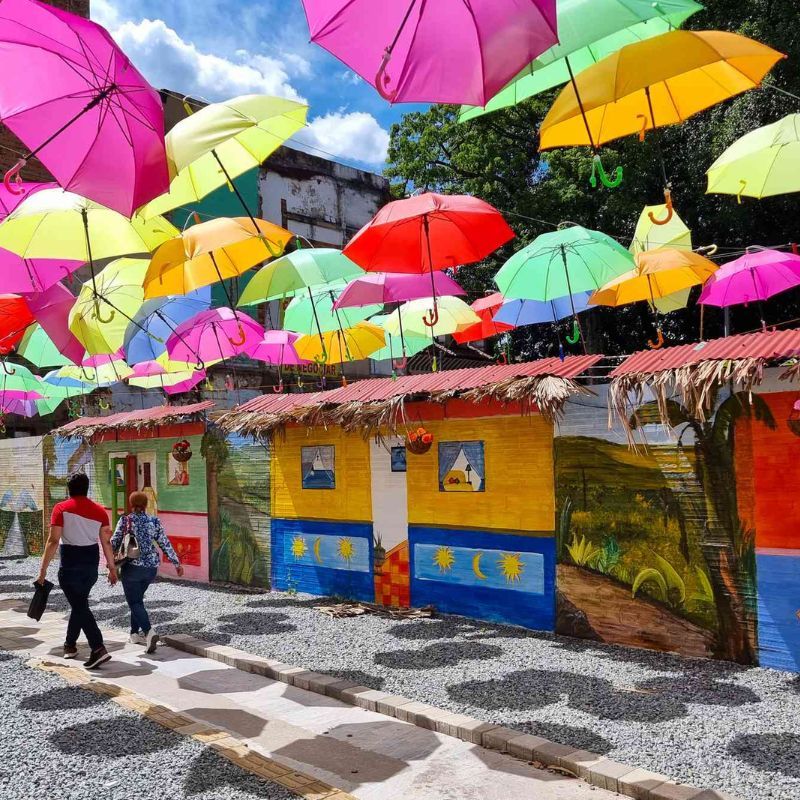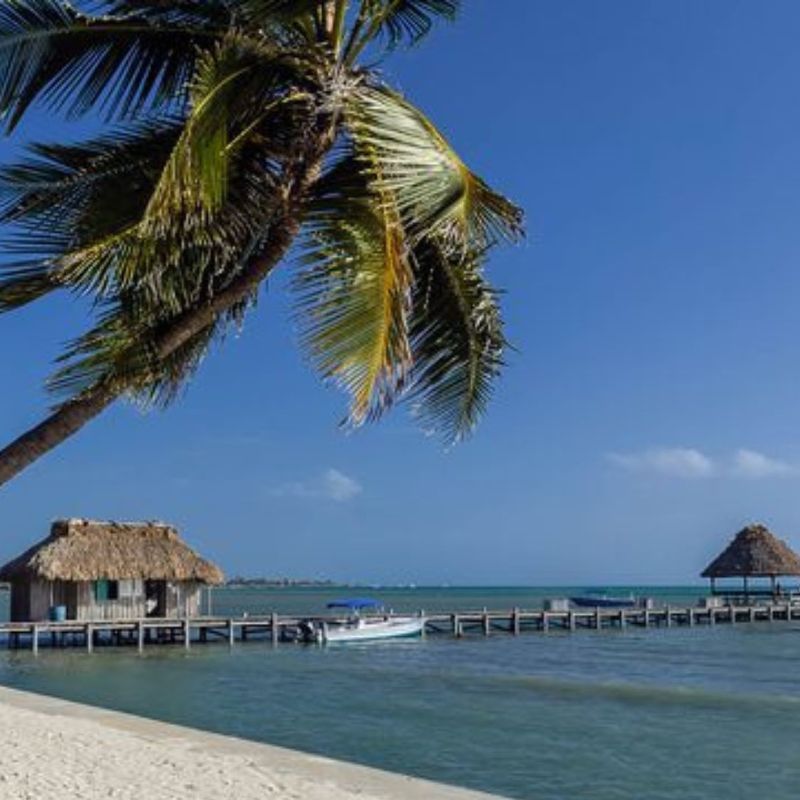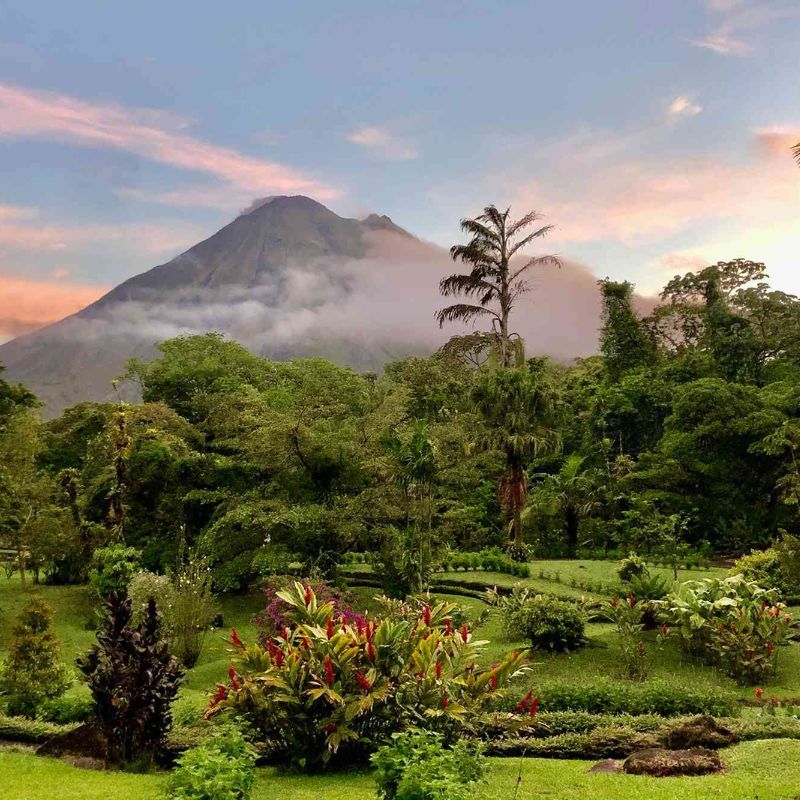
Our helicopter swooped skyward with an easy bound and Panama City came into view almost instantly — hundreds of gleaming skyscrapers silhouetted against the Pacific. A dozen ships queued neatly, waiting to enter the world’s most aesthetically pleasing marvel of engineering: the Panama Canal.
As we zipped above the waterway, I was awed by the audacity of its creation. The canal, completed in 1914, operates 24/7, like a conveyor belt, passing vessels back and forth between the oceans. Ships the length of several football fields glided past tidy parcels of farmland and Soberania National Park, a 55,000-acre natural preserve. From inlets covered in neon-green algae, snow-white egrets took flight over ships stacked with thousands of brightly coloured containers — imagine a mash-up of Gauguin and Mondrian.
Panama has long been seen more as a trading post than a destination. From the days of colonists and pirates to the more modern era (of, say, bankers and lawyers servicing offshore corporations), its touristic charms have gone largely unappreciated. Since the US-led ousting of strongman Manuel Noriega in 1989, the country has marched steadily, if improbably, toward prosperity and political stability.
Here’s how to plan a trip to Panama

With almost 13 million acres of the world’s most biodiverse rain forest, rich with jaguars, hummingbirds, and two thousand butterfly species (take that, Costa Rica), plus some 1,800 miles (2,896.81 km) of unsullied coastline, this country is poised for a tourism boom. Historically, lodgings outside the capital have contented themselves with hosting the budget-conscious backpacker crowd. In the past few years, however, thanks to government initiatives and the efforts of conservation-focused developers, a new class of luxurious resorts has come to offer a cushier way into the country’s insanely unspoiled attractions.
“With almost 13 million acres of the world’s most biodiverse rainforest, Panama is poised for a tourism boom.”

I immediately sensed this newfound energy in Panama City, which felt far more cosmopolitan and international than I had expected. My first stop was Sofitel Legend Casco Viejo, a stately property located on the edge of Panama Bay in the city’s old quarter.

Open since January, the hotel is a thoughtful restoration of the once-chic but long-dormant Union Club, the former gathering place for industrialists and politicians. Decorated with nautical accents, it still has the feel of a private club, or maybe a mansion belonging to a rich auntie who happens to serve grilled octopus on her waterfront terrace.
I’d expected urban chaos beyond the elegant lobby, but a stroll around the neighbourhood proved calm, quiet, and unexpectedly French. The Casco Viejo district dates to the late 17th century and is often compared with New Orleans’s French Quarter. The neighbourhood sprawls for many blocks, a world apart from the skyscrapers of downtown. As I walked down narrow, cobblestoned streets past colonial-era churches and plazas, I understood why it was designated a UNESCO World Heritage site in 1997. Rows of rejuvenated Spanish, French, and Caribbean buildings with latticed balconies and carved wooden doors provide a genteel setting for coffee shops, bars, and restaurants.

I found a burgeoning and eclectic foodie scene at places like Maito, in the ritzy Coco del Mar neighbourhood, which offers a wide-ranging tasting menu of chow mein, ceviche, and pesca afro, a fried white fish served with a coconut curry sauce. The next evening, at Fondo Lo Que Hay, I tried the gaucho, a rice porridge with pork belly, egg, and tomato, before devouring the 74-hour-marinated, double-fried chicken (served with mashed potatoes and a sinful amount of butter).
The liveliest glimpses of life seemed wedged between the old, unreconstructed city and the shinier, up-and-coming version. I was intrigued by the colonies of cats living in the old quarter’s few remaining dilapidated mansions. And I was inspired by the diverse throngs of shoppers along Avenida Central — their faces reflecting Chinese, Indigenous, Spanish, and African heritage, evidence of Panama’s long history of colonisation and commerce.
If Panama City felt like a genuine metropolis, the vibe in Bocas del Toro, an hour’s flight northwest, was distinctly more relaxed. At the end of the 19th century, the United Fruit Company established itself in Bocas (an estimated 325,000 tons of bananas still leave the port each year) and built scores of pastel colonial-style wooden houses, many of which remain intact. Essentially inaccessible by road until the 1980s, the area is distinguished by its rich Caribbean culture and pristine biodiversity.

Bocas Town, as it’s known, is also the gateway to the Bocas del Toro Archipelago, made up of nine islands and more than 200 tiny islets. I was headed to Nayara Bocas del Toro, a private island preserve 20 minutes away by boat, so I made my way to the port, where “traffic” refers not to cars but to the colourful boats, known as pangas, that shuttle between the islands. After making inquiries with several captains who spoke English and Spanish with a pleasing Creole lilt, I found my ride.

Opened in 2021, Nayara Bocas del Toro is entirely off the grid and nearly fully solar-powered. The lodge, which caters to adults only, consists of 16 luxurious overwater villas, each with a private plunge pool and terrace with a firepit.

In the middle of the overwater boardwalk sits the Elephant House, Nayara’s restaurant, a 100-year-old structure imported from Bali. On the land side, two giant mushroom-like tree houses soar 50 feet into the air (there are three more under construction). Created by the Bali-based designer Elora Hardy and crafted from bamboo and sustainably harvested hardwoods, they offered prime views of the sea and the mangrove forest canopy skirting the beach.

Nayara’s owner, a retired tech entrepreneur named Dan Behm, described his pursuit of ultra-sustainability as an ongoing evolution. In 2015, he bought El Castillo, a small luxury hotel on Costa Rica’s southern Pacific coast. Two years later, eager for a new challenge, he found himself scouting Central America for another beachfront property. Soon enough he realised that if he wanted to create something rare and special, he’d have to ditch the beach paradigm. In the end, he bought Isla Frangipani, the tiny island with 88 acres of mangroves where the resort is located. “People talk a lot about sustainability,” he told me, “but sometimes they’re just doing it to look good. Mangroves are the midwives of vast swaths of marine life. If we want to offer access to them, we have to preserve what we find and take care of it.”
I’d arrived in the late afternoon. The sunset was out of view, behind the island, but the placid Caribbean horizon beyond my window offered a contemplative charm all its own. Morning brought rain, pattering on the rooftop, soothing and monsoon-y. When it stopped, I shambled toward the water and was treated to an explosion of flying fish, leaping by the thousands. At lunch on the dock outside the restaurant, I looked down and saw a Cousteau-worthy parade of starfish, sea urchins, manta rays, sea cucumbers, sharks, snappers, and groupers.
With a captain and boat on call for every villa, guests often choose to explore or picnic at secluded beaches on neighbouring islands and cays like Cayos Zapatillas, part of the Bastimentos National Marine Park. For those inclined to stay put, the resort offers snorkelling, kayaking, and stand-up paddleboarding. I gave myself an unguided tour and soon found myself walking in and among the quiet spectacle of the mangroves. They seemed to sprout everywhere, beside and beyond the boardwalk, sprawling with geometric repetition, their exposed roots looking like spider legs. The island’s interior, I learned, is rich with ocelots and sloths. I spotted strawberry poison-dart frogs hopping across the pathways near the elevated man-made beach at the end of the boardwalk. Here indeed was a dense speck of wilderness under preserve.
Shop the best travel experiences here
I left Nayara for Bocas Town by water taxi early the next morning. After living over water with the constant slish-slosh of the waves underneath me, it felt strange to ride in a van. We passed through the Ngäbe-Buglé, one of six communal areas set aside by the Panamanian government for the country’s half-million Indigenous citizens, and the Reserva Forestal Fortuna, a vast forest preserve. After a two-hour drive and a 90-minute boat ride, we docked at Islas Secas, an eco-reserve and lodge spread out on a 14-island archipelago off the coast of southwestern Panama.
The resort, owned by American financier and passionate conservationist Louis Bacon, consists of seven secluded casitas, which sleep a maximum of 24 guests. Bacon, whose foundation funds projects including Taos Ski Valley, in New Mexico, and Robins Island, off Long Island, discovered the area on a fishing trip. Realising that there was no lodging on par with the spectacular scenery and that the islands were up for sale, he decided to add them to his portfolio.
From the moment I arrived at Islas Secas, I knew that leaving would be painful. A greedy reaction, to be sure, but very few places have made me feel that way. The walk from the dock to the dining hall to my villa took me along forest paths with purple flowers and a soundtrack of birdsong. The trees had epiphytes, ferns, bromeliads, and orchids running up their trunks, adding a furry, Dr. Seuss quality to them. Every turn offered a view of an island, a peninsula, or a still-life setting of a vase or bowl filled with exotic flora like amaryllis, bergamot, orange blossoms, and vetiver.

Islas Secas’s villas are built of a variety of certified sustainable woods, including red cedar, Brazilian ipe, and African mahogany. The eclectic sourcing reflects its notion of conservation. “Our idea of sustainability included the concept that, once built, we didn’t want to be constantly remodelling or altering the structures,” explained Tom Scheerer, the property’s interior designer.

The villas’ design — with ample cross ventilation, high-pitched roofs, and wide overhangs to provide natural shade and protection from the rain — was inspired by the century-old houses near the canal. My bathroom had both indoor and outdoor showers, plus an infinity pool. The resort’s low-impact approach extends beyond the villas: the resort runs entirely on solar energy, all food waste is composted, and the wastewater is treated and used to irrigate the grounds.

I was spoiled for choice when it came to Islas Secas’s spa and yoga program. Did I prefer the Big Chill, a treatment involving cold stones and rehydrating rainforest oils? Or Magnificent Me Time, a 90-minute massage and scrub with some reflexology thrown in? Should I take my yoga session poolside or beachside? At sunset or in the moonlight?
I chose to treat myself to the Secas Sound Shower at the spa. I tried my best to relax on a yoga mat as a pair of instructors began to whang a mallet against a big brass bowl. Deep bass vibrations washed over me, and with every clang, I felt like a 14-year-old fighting off the effects of too many bong hits. The instructors walked in circles around me, moving closer and farther from my ears, hitting bowls, wind chimes, a rain stick, a thumb piano, and a tambor oceánico, an instrument filled with pellets that made a sound like breaking waves. During the hour-long session, I felt my inner core of New York stress and self-consciousness fighting to stay intact — then giving way to a feeling of calm.

After lunch, I took a nature hike led by Venicio “Beny” Wilson, the conservation, sustainability, and activities manager, along some of the island’s trails. Wilson gushed about the 100 species of birds as he pointed out kiskadees, vireos, lesser elaenias, and mangrove yellow warblers. Did I know that many birds migrate from south to north? he asked. “We always think of north-south migration,” Wilson said, “but in Panama, we often see birds flying north to escape competition from northern birds heading south.” I mused on the realities of a place that serves as a midpoint between hemispheres before Wilson interrupted me: I should keep my eye out for big toads. “Smoky jungle toads,” he clarified. “We’re doing a study to make sure they’re okay. It’s a good way of measuring our environmental impact. So if you see a toad about four hundred grams, almost as big as a Frisbee, let me know.
The following morning after breakfast, I met my snorkelling guide, Maria Henriquez. Born and raised in Panama City, Henriquez worked in the hospitality industry and had never gone diving until her thirties. The experience changed her life. She became a rescue diver, then a dive master, and has worked as an instructor ever since, joining Islas Secas in 2020.

The moment we jumped into the Gulf of Chiriquí, we were surrounded by what seemed like most of the area’s 750 fish species: dorados; long fin halfbeaks; needlefish; jacks; yellow, red, and gold snappers; angelfish; barber fish; three species of puffer fish; eels; and various kinds of rays. “There are lots of beautiful dive sites in Panama,” Henriquez told me, “but there’s no place that has better stuff than here.” Guests often want to visit nearby Coiba National Park, one of Panama’s largest protected marine areas, to see turtles, whale sharks, and humpbacks, which appear twice a year as they migrate back and forth between the hemispheres.
I decided to set out instead for Pargo Beach, a tiny cove with an enormous uprooted tree trunk artfully deposited at the edge. I kayaked and paddleboarded for an hour before noticing something strange: I hadn’t seen another boat since I’d arrived. An hour later, I’d worked up just enough of an appetite to demolish the enormous lunch of shrimp, mahi-mahi, chicken, and Wagyu steak with chimichurri sauce that the kitchen staff prepared for me right on the beach.
Between the solitude, the undisturbed nature, the peace, and the beauty of it all, I’d love to say I felt like a survivor of a shipwreck, alone on a deserted island. And then I remembered Tom Hanks in Cast Away, painstakingly crafting a net from a salvaged lace dress to catch fish, desperate to stave off hunger. And I realised it wasn’t like that at all.
Where to stay
The American Trade Hotel: Just opposite the Plaza de la Independencia in the city’s Casco Viejo district, this 50-room property mixes Neoclassical architecture with palm-print sofas, Mexican weavings, and colourful tilework. A rooftop pool and a jazz club lend a festive feel to the property.
Book your stay at American Trade Hotel via Booking.com
Book your stay at American Trade Hotel via Agoda.com
Islas Secas: Privacy, exclusivity, and sustainability — this island eco-retreat off the Pacific coast has all three. Guests can enjoy a variety of diversions, from sound baths to snorkelling and whale-watching.
Nayara Bocas del Toro: This adults-only, off-the-grid resort in the Bocas del Toro Archipelago, part of the Nayara Collection, has only 16 overwater villas, some of which have glass floor panels for viewing marine life. Activities include snorkelling, scuba diving, fishing, kayaking, or just wandering through the vast mangroves.
Book your stay at Nayara Bocas del Toro via Booking.com
Sofitel Legend Casco Viejo: Located in the historic district, this former private club is an elegant base for exploring Panama City. The 159-room hotel, which opened in January, preserves much of the original French architecture, from the giant glass chandeliers to the wrought-iron balconies.
Book your stay at Sofitel Legend Casco Viejo, Panama City via Booking.com
Book your stay at Sofitel Legend Casco Viejo via Agoda.com
Where to eat
CasaCasco: The rooftop bar of this restaurant in Casco Viejo serves up excellent cocktails
and views of the city.
Fondo Lo Que Hay: It’s worth the wait at this popular restaurant in the Casco Viejo area, where many of the dishes, including the Caribbean prawns, are cooked over a wood flame.
Maito: Enjoy dishes that reflect Panama’s diverse population, like chow mein and ceviche, at this low-key spot in the ritzy Coco del Mar neighbourhood. Spring for the USD 100 (INR 8,327) tasting menu for a broad sampling of the country’s different cuisines.
Salsipuedes: Located in Bristol Panama, the restaurant has an eclectic menu that includes pork-belly tacos, octopus carpaccio, and fried crocodile.
How to book
Scott Dunn: This luxury agency can design a trip to Panama that includes stays at Sofitel Legend Casco Viejo, Islas Secas, Nayara Bocas del Toro, and the American Trade Hotel, as well as domestic flights and private transfers. Experiences range from a helicopter ride over the Panama Canal to chocolate making.
(Hero and feature image credit: Cristóbal Palma)
This story first appeared on travelandleisure.com
Related: 22 Best Things To Do In Bali — From Volcano Treks To Luxe Spa Days











